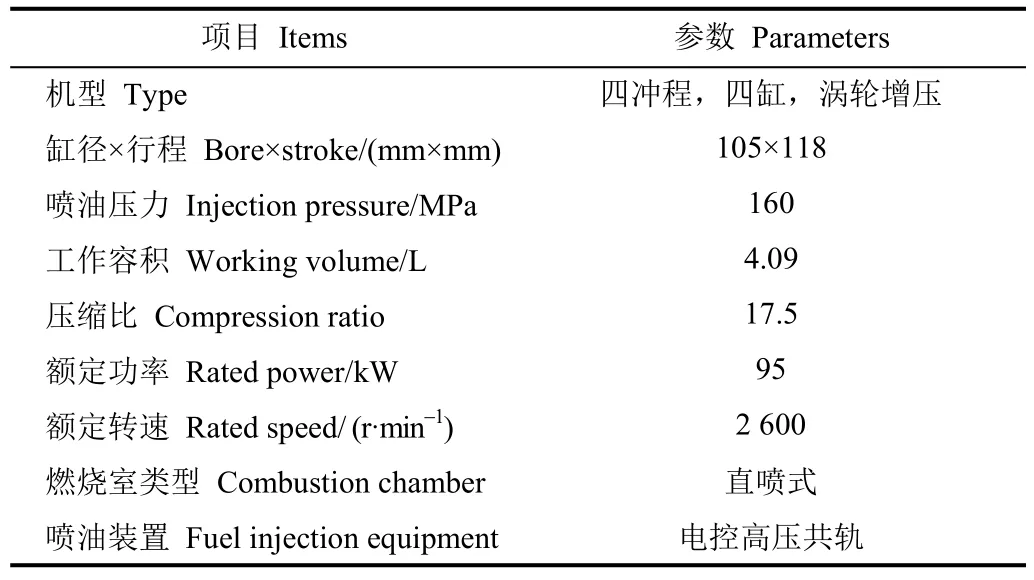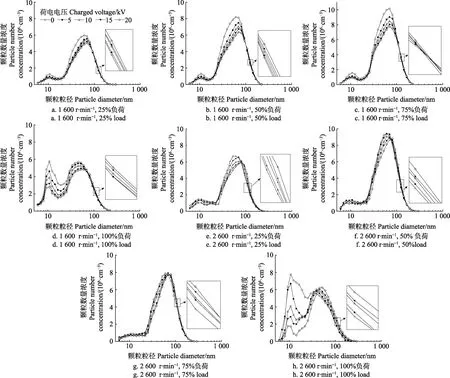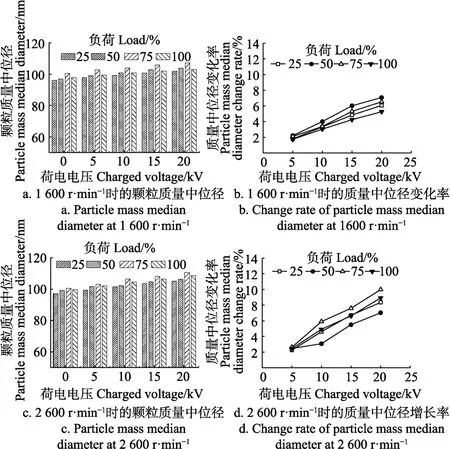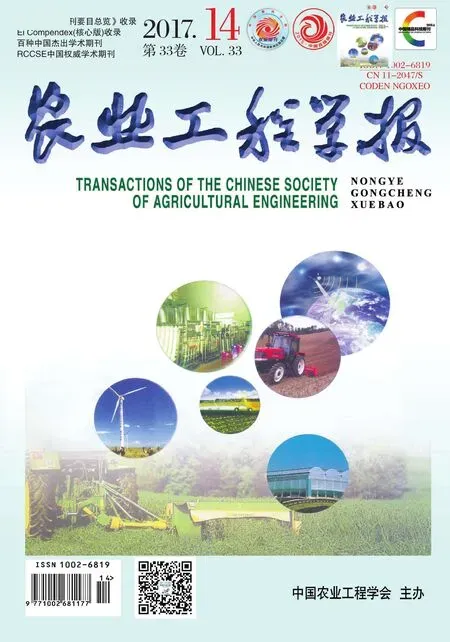双极荷电凝并降低柴油机颗粒排放数量的试验研究
2017-11-24刘军恒平垚万峰
孟 建,刘军恒,孙 平垚,万峰,范 义
(1. 江苏大学汽车与交通工程学院,镇江 212013;2. 山东理工大学交通与车辆工程学院,淄博 255049)
双极荷电凝并降低柴油机颗粒排放数量的试验研究
孟 建1,2,刘军恒1※,孙 平1垚,万峰1,范 义1
(1. 江苏大学汽车与交通工程学院,镇江 212013;2. 山东理工大学交通与车辆工程学院,淄博 255049)
针对柴油机排气颗粒粒径小、数量浓度高难以控制的问题,以共轨柴油机排气颗粒为研究对象,采用自制的荷电凝并试验台,研究了在1 600和2 600 r/min转速下,荷电电压(0、5、10、15、20 kV)对排气颗粒数量浓度分布、质量密度分布、质量中位径、总数量浓度和柴油机颗粒捕集器(diesel particulate filter,DPF)捕集效率等的影响。试验结果表明,双极荷电凝并能够降低柴油机排气颗粒的总数量浓度,核模态颗粒(5~50 nm)和小于93.1 nm积聚态颗粒(50~500 nm)数量浓度降低,大于93.1 nm的积聚态颗粒数量浓度略有升高。随着荷电电压的升高,2种转速下(最大扭矩转速1 600 r/min和额定转速2 600 r/min),25%负荷、50%负荷和75%负荷时,45.3~80.6 nm峰值处颗粒数量浓度随荷电电压的升高降幅明显,100%负荷时,8.06~12.4 nm峰值处颗粒数量浓度降幅明显高于45.3~80.6 nm峰值处;颗粒质量浓度峰值向大粒径方向偏移,质量中位径范围由96~101 nm增大至102~110 nm。双极荷电凝并能够提高DPF的捕集效率,降低柴油机排气颗粒的数量和质量排放,50%负荷时,10 kV下的DPF的捕集效率较0 kV提高了9个百分点。该研究可为双极荷电凝并技术的车用提供参考。
柴油机;排放控制;颗粒物;双极荷电;颗粒数量浓度;捕集效率
0 引 言
柴油机排气颗粒是大气颗粒物的主要来源之一,大部分颗粒粒径小于100 nm[1-3],不易沉降,造成环境污染并危害人体健康[4-5],最新研究表明小于100 nm的颗粒能轻易穿透人体细胞壁进入血液与大脑,甚至能导致某些遗传性疾[6],因此,控制柴油机颗粒排放尤其是小粒径颗粒排放具有重要的意义。近年来世界各国越来越重视柴油机颗粒排放数量,欧Ⅴ和欧Ⅵ排放法规中增加了针对颗粒排放数量的限值要求[7]。柴油机颗粒捕集器(diesel particulate filter,DPF)是目前公认降低柴油机颗粒排放最有效的手段,广泛应用于车用柴油机[8-10],但 DPF对于超细颗粒的捕集效率较低[11-14]。 降低DPF载体孔隙粒径,能够提高捕集效率,但会造成DPF压降增大,导致柴油机燃烧恶化;在不改变DPF过滤体结构参数的情况下,增大排气颗粒粒径,能够有效提高捕集效率[11]。
双极荷电凝并能够提高颗粒间的碰撞概率,增大凝并系数[15],使带电颗粒更易于凝并成较大颗粒,促进颗粒粒径增长,该技术长期以来一直被国内外学者重视,并在电场除尘领域取得了很好的效果[16-19]。Eliasson等[16]通过试验研究了异极性荷电粉尘的凝并效率,发现在对称偶极荷电时,亚微米颗粒静电凝并速率较中性颗粒热凝并速率高102~104倍。Koizumi等[17]计算了外电场作用下双极性荷电颗粒的凝并系数,而亚微米颗粒异极性荷电后在非对称状态下较对称时凝并效果好,但是随着凝并的进行大多数新生成颗粒带电荷量少,不利于凝并过程的继续进行。张向荣等[18-19]在理论分析和数值模拟的基础上,通过求解荷电颗粒凝并数量平衡方程,比较了颗粒数量浓度在有外电场和无电场条件下的变化规律,定量分析了外电场对荷电颗粒凝并的影响。
上述已开展的颗粒荷电凝并研究工作,大部分是针对燃煤烟气颗粒的凝并过程,柴油机颗粒相比于燃煤烟气颗粒,颗粒粒径更小、更不规则、化学组分更加复杂[20],因此其荷电性能、凝并过程也将发生显著变化。朱泽洪[21]研究了交流荷电电压对柴油机颗粒形貌的影响,同时研究了交流荷电电压对DPF过滤效率的影响,结果表明交流电压为6 kV时,颗粒质量中位径增加,DPF过滤效率增加。目前针对柴油机排气颗粒双极荷电凝并的研究鲜有报道。本文以高压共轨柴油机排气颗粒为研究对象,应用发动机排气粒径谱仪(engine exhaust particle sizerspectrometer,EEPS)和微粒采样分析仪(AVL SPC472),研究了荷电电压对颗粒数量浓度、质量中位径、总数量浓度和DPF捕集效率的影响规律。
1 试验装置与方法
1.1 试验系统与设备
双极荷电凝并试验系统如图 1所示,主要包括台架系统、荷电与凝并装置、测量系统等。台架系统主要包括:电涡流测功机(CAC250,湘仪动力测试仪器有限公司),用来控制柴油机转速和扭矩;YZ4DB1-40柴油机(潍柴动力扬州柴油机有限责任公司),其主要结构参数及性能如表1所示,试验时不改变原机的喷油时刻、喷油压力等控制参数。燃料为市购国Ⅳ0#柴油。
荷电与凝并装置主要包括:TE4020高压直流电源(大连泰思曼科技有限公司),用于对柴油机排气颗粒荷以正、负电荷,该高压电源可以在0~±50 kV连续可调,最大输出电流为1 mA;陶瓷电热圈控制荷电处的排气温度,功率5 kW,温度控制精度为±10 ℃。
测量系统主要包括:EEPS-3090发动机排气粒径谱仪(美国 TSI 公司)用于测试颗粒的数量浓度,该设备测量的粒径范围为5.6~560 nm,粒径分辨率为16通道每10倍粒径(共32通道),内部安装有两级稀释系统,一级稀释系统为旋转盘式热稀释器,二级稀释系数为热空气调节器系统,采样频率为10 Hz,可直接在线测量发动机排气颗粒的粒径和数量,能够满足柴油机瞬态工况下对颗粒数量的测量要求;SPC472微粒采样分析仪(奥地利AVL公司),用来采集柴油机排气颗粒;MX-5型微克天平(瑞士梅特勒-托利多公司),精度 1μg,用于测量采集颗粒质量。

表1 YZ4DB1-40型柴油机主要性能及结构参数Table 1 Properties and structure parameters of YZ4DB1-40 diesel engine

图1 双极荷电凝并试验装置系统图Fig.1 Schematic diagram of bipolar charged coagulation experimental system
1.2 试验设计
1.2.1 排气颗粒数量浓度试验
试验选取柴油机最大扭矩转速1 600 r/min和额定转速2 600 r/min下25%、50%、75%和100%负荷作为试验工况点。每个工况点下分别调节电压为 0、±5、±10、±15和±20 kV(如±5 kV时,正高压电源电压为5 kV,负高压电源为-5 kV)测量排气颗粒数量浓度。为保证试验结果的可靠性,柴油机冷却水温度、机油温度分别达到80 ℃和90 ℃后进行测量;柴油机工况点发生改变时,柴油机稳定运转30 min后再进行测量;电压改变时,高压电源电压稳定5 min后再进行测量;为降低排气温度对颗粒荷电的影响,在荷电装置安装陶瓷电热圈,设定温度控制为300 ℃。试验时EEPS-3090设定一级稀释系统的稀释比为 100∶1,二级稀释系统的稀释比为 2∶1,控制总稀释比为200∶1;对排气颗粒连续采集120 s,最终结果取120 s平均值。高压电源工作时,其耗功率范围为0~8 W,车载12 V或24 V直流电源能够通过逆变电源输出±20 kV直流电,对荷电装置供电,为装车实用提供了可能。
1.2.2 DPF捕集效率试验
选取1 600 r/min下的50%负荷作为DPF捕集效率试验的工况点,利用AVL SPC472分别采集DPF前后端的颗粒,采样时间设定为30 min;用MX-5型微克天平测量采样前后的滤纸质量,采样后滤纸质量减去采样前滤纸质量即为此次采集的颗粒质量。为保证测量精度,采样滤纸在采样前后分别放入干燥皿中干燥 2 h然后再进行称质量。DPF过滤体为壁流式陶瓷过滤体,其孔密度为100 CSI。
2 试验结果与分析
2.1 荷电电压对颗粒数量浓度的影响
柴油机颗粒按照粒径大小,可以划分为核模态颗粒和积聚态颗粒,其粒径范围分别为 5~50 nm 和 50~500 nm[1,22-23]。
图2为柴油机在1 600和2 600 r/min时,25%、50%、75%和 100%负荷下,荷电电压对柴油机排气颗粒数量浓度的影响。从图2中可以看出,在2种转速下,不同负荷和不同电压的颗粒数量浓度均为双峰分布,峰值分别在8.06~12.4 nm和45.3~80.6 nm之间;0 kV时,2 600 r/min时的排气颗粒数量浓度在4种负荷下均高于1 600 r/min时的浓度。0 kV时,25%、50%和75%负荷下45.3~80.6 nm峰值处的数量浓度明显高于8.06~12.4 nm峰值处的数量浓度,而且75%负荷时45.3~80.6 nm峰值处的数量浓度最高;100%负荷时,2个峰值处的颗粒数量浓度基本相同,但8.06~12.4 nm峰值处的数量浓度明显高于其他负荷。在4种负荷下,相比荷电电压为0 kV,荷电电压5、10、15、20 kV时,核模态颗粒和低于93.1 nm的积聚态颗粒的数量浓度降低,高于93.1 nm的积聚态颗粒数量浓度略有升高。随着荷电电压的升高,25%、50%和75%负荷时,45.3~80.6 nm峰值处颗粒数量浓度降幅明显;在100%负荷时,8.06~12.4 nm之间的颗粒数目降幅明显高于45.3~60.4 nm之间的颗粒。对于单分散颗粒,颗粒间的凝并系数与颗粒数量浓度的平方成正比[24];对于多分散颗粒由于小粒径颗粒具有更高的扩散系数会进一步提高颗粒的凝并进程[25-26],颗粒带有不同极性电荷后,由于异极性荷电颗粒间存在库伦力,能够增加颗粒间碰撞概率,提高凝并系数[27-28]。随着荷电电压的提高,荷电装置内的电场强度增大,致使颗粒荷电量增多,从而提高了异极性荷电颗粒间的库仑力,进一步增大了碰撞概率,颗粒间的相互多次碰撞、凝并,导致小粒径颗粒数量降低,同时部分颗粒粒径增大,导致了小粒径颗粒数量浓度随荷电电压升高而降低,大粒径颗粒数量浓度增多的现象。在100%负荷时,由于8.06~12.4 nm峰值处的颗粒数量浓度较高,且带有电荷的小粒径颗粒具有更高的扩散系数,因此该峰值处颗粒数量浓度降幅明显。

图2 柴油机不同转速不同负荷下排放颗粒数量浓度Fig.2 Diesel engine particles number concentration at different rotational speeds and loads
2.2 荷电电压对颗粒总数量浓度的影响
图3为1 600和2 600 r/min时,在25%、50%、75%和100%负荷下,不同荷电电压对柴油机排气颗粒总数量浓度及其变化率的影响。从图3中可以看出,2种转速时,4种负荷下的排气颗粒总数量浓度均随着荷电电压的升高降低;排气颗粒总数量浓度降幅随着荷电电压升高而增大。颗粒总数量浓度变化率由式(1)计算

式中R为颗粒总数量浓度变化率,%;nt0为0 kV时的颗粒总数量浓度,颗/cm3;nti为荷电电压不为0 kV时的颗粒总数量浓度,颗/cm3。
100%负荷时,与0 kV相比,5、10、15和20 kV下的颗粒总数量浓度在1 600 r/min时,分别降低了9.71%、16.78%、21.92%和25.18%;在2 600 r/min时,分别降低了11.21%、15.19%、21.91%和25.33%。在荷电电压相同时,与其他3种负荷相比,100%负荷下颗粒总数量浓度降幅最大,其原因在于100%负荷下的小粒径颗粒数量浓度最高,由于其具有更高的扩散系数,增大了与其它颗粒的碰撞概率,提高了凝并系数,因此100%负荷下的颗粒总数量降低明显。

图3 柴油机不同转速不同负荷下的排放颗粒总数量浓度Fig. 3 Total particles number concentration at different rotational speeds and loads of diesel engine
2.3 荷电电压对质量密度分布和质量中位径的影响
选取质量密度分布和质量累积分布作为颗粒分散度的评价指标[29-30]。颗粒质量密度分布由式(2)计算

式中fm为颗粒密度分布;ni为第i个区间离子数目,颗/cm3;dpi为第i个区间里的颗粒粒径,nm;Δdpi为第i个区间的粒径范围,nm。
质量累积分布定义为小于某一粒径的所有粒子的质量占总质量的分数,由式(3)计算

式中Fm为颗粒质量累积分布;dp为颗粒粒径,nm。
颗粒质量累积分布 50%时所对应的颗粒粒径称为质量中位径,记作dpm50,可以近似代替颗粒几何平均粒径。图4为1 600 r/min时,不同荷电电压下的柴油机排气颗粒质量密度分布图。由图 4可以看出,随着荷电电压升高,核模态颗粒和低于93.1 nm的积聚态颗粒的质量密度降低,高于93.1 nm的积聚态颗粒质量密度升高,颗粒质量密度分布向大粒径方向偏移,同时峰值增大,且峰值对应的颗粒粒径增加。20 kV时,颗粒质量密度分布峰值最大,与0 kV相比,25%、50%、75%和100%负荷下的颗粒质量密度分布峰值分别提高了8.06%、9.92%、9.51%和7.28%。

图4 柴油机1 600 r·min-1时不同负荷下的排放颗粒质量密度分布Fig. 4 Distribution of particles mass density under different diesel engine load at 1 600 r·min-1
图5为1 600 r/min时,4种负荷下的颗粒质量累积分布随荷电电压的变化规律,由图 5中可以看出,随着荷电电压的增高,颗粒质量累积分布曲线向大粒径方向移动,荷电电压越高,偏移量越大。其原因为荷电电压增加后,颗粒荷电量增加,异极性颗粒间的库仑力增大,凝并过程增强,单位时间内颗粒碰撞的次数增加,导致颗粒粒径变大。
图6给出了1 600和2 600 r/min转速时,4种负荷下排气颗粒质量中位径及其变化率随荷电电压的变化。从图6中可以看出,在相同负荷下,与1 600 r/min相比,2 600 r/min转速下的排气颗粒质量中位径略高;2种转速时,与其他负荷相比,75%负荷下的排气颗粒质量中位径最大。在2种转速下,与0 kV时相比,4种负荷的排气颗粒质量中位径均随着荷电电压的增加而增大,质量中位径范围由96~101 nm增大至102~110 nm;在同一负荷下,荷电电压越高,质量中位径增幅越大。其原因主要是荷电电压越高,颗粒荷电量越大,颗粒间的库伦凝并系数越高,在相同凝并时间内,颗粒碰撞频率越高,由小粒径颗粒凝并形成的大粒径颗粒数目增加,大粒径颗粒所占比重上升。

图5 柴油机1 600 r·min-1时的排放颗粒质量累积分布Fig. 5 Distribution of particles mass accumulation at 1 600 r·min-1 of diesel engine

图6 柴油机不同转速不同负荷下排放颗粒质量中位径及其变化率Fig. 6 Particles mass median diameter and change rate at different rotational speeds and loads of diesel engine
2.4 荷电电压对DPF捕集效率的影响
捕集效率η是评价DPF性能的重要指标

式中η为DPF捕集效率,%;m1为在DPF前端采集的颗粒质量,mg;m2为在DPF后端采集的颗粒质量,mg。
图7为1 600 r/min,50%负荷时荷电凝并(荷电时的电压为10 kV)前后DPF捕集效率的变化规律。从图7中可以看出柴油机排气颗粒经荷电凝并后,从DPF后端采集的颗粒质量明显降低,连续3次试验结果显示,DPF后的颗粒质量分别从0 kV时的0.243、0.237和0.224 mg下降到10 kV时的0.115、0.121和0.117 mg,分别下降了52.7%、48.9%和47.8%;平均颗粒质量从0.235 mg下降到0.118 mg,下降了49.8%。与0 kV时相比,10 kV时DPF的平均捕集效率由82.1%增加到91.1%,提高了9个百分点。由此可见,在不改变DPF过滤体结构参数的情况下,双极荷电凝并能够提高DPF捕集效率,同时降低颗粒数量与质量排放。

图7 1 600 r·min-1转速下柴油机在荷电电压 0和10 kV下DPF的捕集效率(50%负荷)Fig. 7 Trap efficiency of DPF at charged voltage 0 and10 kV at 1600 r·min-1 of diesel engine(50% load)
3 结 论
1)双极荷电凝并能够降低柴油机排气颗粒的数量浓度,随着荷电电压的升高,核模态颗粒数量浓度降低,大于93.1 nm的积聚态颗粒数量浓度略有升高。25%负荷、50%负荷和75%负荷时,45.3~80.6 nm峰值处颗粒数量浓度随荷电电压的升高降幅明显;100%负荷时,8.06~12.4 nm峰值处颗粒数量浓度降低幅度最大。
2)颗粒总数量浓度随荷电电压的升高而降低,荷电电压越高,降幅越大;颗粒质量浓度峰值、颗粒质量中位径均随荷电电压的升高而增加,荷电电压越高,增幅越明显。
3)双极荷电凝并能够提高DPF的捕集效率,降低柴油机排气颗粒的数量和质量排放,荷电电压为10 kV时DPF的捕集效率较0 kV提高了9个百分点。
[1] 王忠,孙波,赵洋,等. 小型非道路柴油机排气管内颗粒的粒径分布与氧化特性[J]. 农业工程学报,2016,32(10):41-46.Wang Zhong, Sun Bo, Zhao Yang, et al. Characteristics of particle coagulation and oxidation in exhaust pipe of diesel engine[J]. Transactions of the Chinese Society of Agricultural Engineering (Transactions of the CSAE), 2016,32(10): 41-46. (in Chinese with English abstract)
[2] Geng P, Yao C, Wei L, et al. Reduction of PM emissions from a heavy-duty diesel engine with diesel/methanol dual fuel[J]. Fuel, 2014, 123(1): 1-11.
[3] Agarwal A K, Dhar A, Gupta J G, et al. Effect of fuel injection pressure and injection timing on spray characteristics and particulate size-number distribution in a biodiesel fuelled common rail direct injection diesel engine[J]. Applied Energy,2014, 130(5): 212-221.
[4] 高敏,仇天雷,贾瑞志,等. 北京雾霾天气生物气溶胶浓度和粒径特征[J]. 环境科学,2014,35(12):4415-4421.Gao Min, Qiu Tianlei, Jia Ruizhi, et al. Concentration and size distribution of bioaerosols at non-haze and haze days in Beijing[J]. Environmental Science, 2014, 35(12): 4415-4421. (in Chinese with English abstract)
[5] Ema M, Naya M, Horimoto M, et al. Developmental toxicity of diesel exhaust: A review of studies in experimental animals[J]. Reproductive Toxicology, 2013, 42(23): 1-17.
[6] Oravisjärvi K, Pietikäinen M, Ruuskanen J, et al. Diesel particle composition after exhaust after-treatment of an offroad diesel engine and modeling of deposition into the human lung[J]. Journal of Aerosol Science, 2014, 69(2): 32-47.
[7] 倪计民,刘越,石秀勇,等. 可变喷嘴涡轮增压及废气再循环系统改善柴油机排放性能[J]. 农业工程学报,2016,32(16):82-88.Ni Jimin, Liu Yue, Shi Xiuyong, et al. Variable nozzle turbine combined with venturi exhaust gas recirculation system improving emission performance of diesel engines[J].Transactions of the Chinese Society of Agricultural Engineering (Transactions of the CSAE), 2016, 32(16): 82-88. (in Chinese with English abstract)
[8] Lapuerta M, Oliva F, Agudelo J R, et al. Effect of fuel on the soot nanostructure and consequences on loading and regeneration of diesel particulate filters[J]. Combustion &Flame, 2012, 159(2): 844-853.
[9] 龚金科,黄迎,蔡皓,等. 柴油机壁流式过滤体灰烬深床沉积数学模型[J]. 农业工程学报,2011,27(3):137-141.Gong Jinke, Huang Ying, Cai Hao, et al. Mathematical model of diesel wall-flow filter for ash deep-bed deposition process[J]. Transactions of the Chinese Society of Agricultural Engineering (Transactions of the CSAE), 2011,27(3): 137-141. (in Chinese with English abstract)
[10] 刘少康,孙平,刘军恒,等. 铈基燃油催化剂改善柴油机颗粒物捕集器再生效果[J]. 农业工程学报,2016,32(1):112-117.Liu Shaokang, Sun Ping, Liu Junheng, et al. Ce-based fuel borne catalyst enhancing regenerative effect of diesel particulate filter[J]. Transactions of the Chinese Society of Agricultural Engineering (Transactions of the CSAE), 2016,32(1): 112-117. (in Chinese with English abstract)
[11] 伏军,龚金科,袁文华,等. 微粒捕集器再生背压阈值MAP 图建立及其应用[J]. 农业工程学报,2013,29(12):47-56.Fu Jun, Gong Jinke, Yuan Wenhua, et al. Establishment and application of MAP for regeneration back-pressure threshold value of diesel particulate filter[J]. Transactions of the Chinese Society of Agricultural Engineering (Transactions of the CSAE), 2013, 29(12): 47-56. (in Chinese with English abstract)
[12] 方奕栋,楼狄明,胡志远,等. DOC+DPF对生物柴油发动机排气颗粒理化特性的影响[J]. 内燃机学报,2016(2):142-146.Fang Yidong, Lou Diming, Hu Zhiyuan, et al. Effects of DOC+DPF on physical and chemical characteristics of pm emitted from diesel engine fueled with biodiesel blends[J].Transactions of CSICE, 2016(2): 142-146. (in Chinese with English abstract)
[13] Yoon S, Quiros D C, Dwyer H A, et al. Characteristics of particle number and mass emissions during heavy-duty diesel truck parked active DPF regeneration in an ambient air dilution tunnel[J]. Atmospheric Environment, 2015, 122:58-64.
[14] 孟 建,刘军恒,孙 平,等. CeO2纳米颗粒催化柴油燃烧氧化特性分析[J]. 农业工程学报,2016,32(22):93-99.Meng Jian, Liu Junheng, Sun Ping, et al. Analysis of oxidation characteristics on combustion of diesel fuels with CeO2nano-catalyst particulates[J]. Transactions of the Chinese Society of Agricultural Engineering (Transactions of the CSAE), 2016, 32(22): 93-99. (in Chinese with English abstract)
[15] 何剑,刘道清,徐国胜. 一体式双极荷电凝并器试验研究[J]. 中国电机工程学报,2013,33(17):45-50.He Jian, Liu Daoqing, Xu Guosheng. Experimental research on integrative bipolar charged agglomerator[J]. Proceedings of the CSEE, 2013, 33(17): 45-50. (in Chinese with English abstract)
[16] Eliasson B, Egli W. Bipolar coagulation-modeling and applications[J]. Journal of Aerosol Science, 1991, 22(4):429-440.
[17] Koizumi Y, Kawamura M, Tochikubo F, et al. Estimation of the agglomeration coefficient of bipolar-charged aerosol particles[J]. Journal of Electrostatics, 2000, 48(2): 93-101.
[18] 张向荣,王连泽. 外电场对双极荷电颗粒碰撞及凝聚的影响[J]. 北京理工大学学报,2012,32(1):91-94.Zhang Xiangrong, Wang Lianze. Effects of an external electric field on the collision and agglomeration between bipolarly charged particles[J]. Transactions of Beijing Institute of Technology, 2012, 32(1): 91-94. (in Chinese with English abstract)
[19] Tan B, Wang L, Zhang X. The effect of an external DC electric field on bipolar charged aerosol agglomeration[J].Journal of Electrostatics, 2007, 65(2): 82-86.
[20] Kittelson D B. Engines and nanoparticles: A review[J].Journal of Aerosol Science, 1998, 29(5/6): 575-588.
[21] 朱泽洪. 基于荷电凝并装置的柴油机试验分析及耦合DPF的应用研究[D]. 镇江:江苏大学,2016.Zhu Zehong. Experimental Analysis and Application Research on Diesel Engine with Charged Agglomerator Coupling DPF[D]. Zhenjiang: Jiangsu University, 2016. (in Chinese with English abstract)
[22] 陆叶强,陈秋方,孙在,等. 汽车排放超细微粒数浓度及粒径谱特征的实验研究[J]. 环境科学,2014(9):3309-3314.Lu Yeqiang, Chen Qiufang, Sun Zai, et al. Ultrafine particle number concentration and size distribution of vehicle exhaust ultrafine particles[J]. Environmental Science, 2014(9): 3309-3314. (in Chinese with English abstract)
[23] 王晓燕,李芳,葛蕴珊,等. 甲醇柴油与生物柴油微粒排放粒径分布特性[J]. 农业机械学报,2009,40(8):7-12.Wang Xiaoyan, Li Fang, Ge Yunshan, et al. Particle size distribution of particulate matter emission from the diesel engine burning methanol-diesel fuel and biodiesel[J].Transactions of the Chinese Society for Agricultural Machinery,2009, 40(8): 7-12. (in Chinese with English abstract)
[24] 孙在,黄震,王嘉松. 亚微米颗粒物的沉积与凝并的模拟与实验研究[J]. 上海交通大学学报,2007,41(10):1710-1713.Sun Zai, Huang Zhen, Wang Jiasong. Modeling and experimental studies on the deposit ion and coagulation of submicron particles[J]. Journal of Shanghai Jiaotong University, 2007, 41(10): 1710-1713. (in Chinese with English abstract)
[25] 陈亮. 柴油燃料燃烧碳烟颗粒生成机理与演变规律的试验和数值研究[D]. 武汉:华中科技大学,2013:50-65.Chen Liang. Experimental and Numerical Study on the Formation Mechanism and Evolution of Soot Particles in Diesel Fuel Combusion Process[D]. Wuhan: Huazhong University of Science and Technology, 2013: 50-65. (in Chinese with English abstract)
[26] 陈厚涛,赵兵,徐进,等. 燃煤飞灰超细颗粒物声波团聚清除的实验研究[J]. 中国电机工程学报,2007,27(35):28-32.Chen Houtao, Zhao Bing, Xu Jin, et al. Experimental study on acoustic agglomeration of ultrafine fly ash particles[J].Proceedings of the CSEE, 2007, 27(35): 28-32. (in Chinese with English abstract)
[27] Wang L, He M, Meng Y. Elementary research on coagulation of bipolar charged dust particles[J]. Environmental Engineering, 2002, 20(3): 31-33.
[28] Tan B, Wang L, Wu Z. Electrostatic coagulation of bipolar-charged particles in an external AC electric field[J].Journal of Tsinghua University, 2009, 49(2): 301-304.
[29] 冯旭,张国华,孙其诚. 颗粒尺寸分散度对颗粒体系力学和几何结构特性的影响[J]. 物理学报,2013,62(18):184501-184501.Feng Xu, Zhang Guohua, Sun Qicheng. Effects of size polydispersity on mechanical and geometrical properties of granular system[J]. Acta Physica Sinica, 2013, 62(18):184501-184501. (in Chinese with English abstract)
[30] 郑强强,张晓东,刘亚丽,等 双气体射流作用下燃煤可吸入颗粒团聚研究[J]. 环境工程,2016(2):69-73.Zheng Qiangqiang, Zhang Xiaodong, Liu Yali, et al.Investigation into agglomeration process of inhalable particle in double gas-jets[J]. Environmental Engineering, 2016(2):69-73. (in Chinese with English abstract)
Experimental research on decreasing particles emission number of diesel engine by bipolar charged coagulation
Meng Jian1,2, Liu Junheng1※, Sun Ping1, Wan Yaofeng1, Fan Yi1
(1.School of Automobile and Traffic Engineering, Jiangsu University, Zhenjiang212013,China;2.School of Transportation and Vehicle Engineering, Shandong University of Technology, Zibo255049,China)
It is difficult to control the particle number emission of diesel engine due to the high number concentration of nanometer particles. To solve this problem, a self-made bipolar charged coagulation test-bed was designed in this study to study the relationship between the particle number concentration of diesel engine and charged voltage. The particle number concentration, particle mass density distribution, particle total number concentration, particle mass median diameter of a common rail diesel engine (the operation conditions of diesel engine were 25% load, 50% load, 75% load and 100% load at 1,600 r/min and 2,600 r/min) under different charged voltages(0, 5, 10, 15 and 20 kV) were measured using an engine exhaust particle sizer spectrometer (EEPS-3090). The trap efficiency of diesel particulate filter (DPF) under 0 kV and 10 kV charged voltages at 50% load was measured using particle collection system (AVL SPC 472) and a microgram electronic balance (MX-5). Experimental results showed that bipolar charged coagulation could reduce the total particle number concentration of diesel engine. With the increase of charged voltage, at 50% load, the particle number concentration of nuclear mode particles (5~50 nm) and accumulation mode particles (<93.1 nm) were reduced, and the number concentration of accumulation mode particles (>93.1 nm) increased slightly, and at the same time the peak of particle number concentration dropped significantly. At 100% load, with the increase of charged voltage, the particle number concentration of diesel engine was in a normal bimodal distribution obviously under different charged voltage, the number concentration of decreased nuclear mode particles (5~50nm) and accumulation mode particles (<93.1 nm) reduced sharply, and the number concentration of accumulation mode particles (>93.1 nm) decreased slightly. At 100% load, the particle number concentration decreased mostly in the number concentration peak of small particles. With the increase of charged voltage, the particle total number concentration decreased. At 50% load, compared with 0 kV, the particle total number concentration decreased by 9.28%,16.23%, 18.17% and 20.56% for 5, 10, 15 and 20 kV, respectively. While at 100% load, compared with 0 kV, the particle total number concentration decreased by 9.71%、16.78%、21.92% and 25.18% for 5, 10, 15 and 20 kV, respectively. At the same charged voltage, the particle total number concentration at 100% load decreased more obviously than 25% load, 50% load and 75% load. With the increase of charged voltage, the peak of particle mass density distribution moved to larger particles.Compared with 0 kV, the peak of particle mass density distribution at 20 kV increased by 8.06%、9.92%、9.51% and 7.28% for 25% load, 50% load, 75% load and 100% load, respectively. The curves of particle mass cumulative distribution moved to larger particles with the increase of charged voltage at 25% load, 50% load, 75% load and 100% load. With the increase of charged voltage from to 0 kV to 20 kV, the range of particle mass median diameter increased from 96~101 nm to 102~110 nm.Compared with 0 kV, the trap efficiency of DPF (diesel particulate filter) at 10 kV increased from 82.1% to 91.1%. In summary, bipolar charged coagulation could increase the trap efficiency of DPF, and reduce the particle number emission and particle mass emission of diesel engine. The results can provide a technical reference for the application of bipolar charged voltage in automobile.
diesel engines; emission control; particles; bipolar charge; particle number concentration; trap efficiency
10.11975/j.issn.1002-6819.2017.14.011
TK421+.5
A
1002-6819(2017)-14-0078-07
孟 建,刘军恒,孙 平,万垚峰,范 义. 双极荷电凝并降低柴油机颗粒排放数量的试验研究[J]. 农业工程学报,2017,33(14):78-84.
10.11975/j.issn.1002-6819.2017.14.011 http://www.tcsae.org
Meng Jian, Liu Junheng, Sun Ping, Wan Yaofeng, Fan Yi. Experimental research on decreasing particles emission number of diesel engine by bipolar charged coagulation[J]. Transactions of the Chinese Society of Agricultural Engineering (Transactions of the CSAE), 2017, 33(14): 78-84. (in Chinese with English abstract) doi:10.11975/j.issn.1002-6819.2017.14.011 http://www.tcsae.org
2017-01-11
2017-05-29
江苏省高校自然科学研究重大项目(10KJA470001);江苏省自然科学基金(BK20160538);江苏省高校自然科学研究面上项目资助(16KJB470003);内燃机燃烧学国家重点实验室开放基金资助项目(K2016-05);国家自然科学基金资助项目(51249001)
孟 建,男,山东滕州,博士,讲师,主要从事内燃机排放与控制方面研究。镇江 江苏大学汽车与车辆工程学院,212013。
Email:tzwzmj@163.com
※通信作者:刘军恒,男,河南安阳,讲师,博士,主要从事内燃机燃烧与排放控制技术研究。镇江 江苏大学汽车与交通工程学院,212013。
Email:liujunheng@ujs.edu.cn
